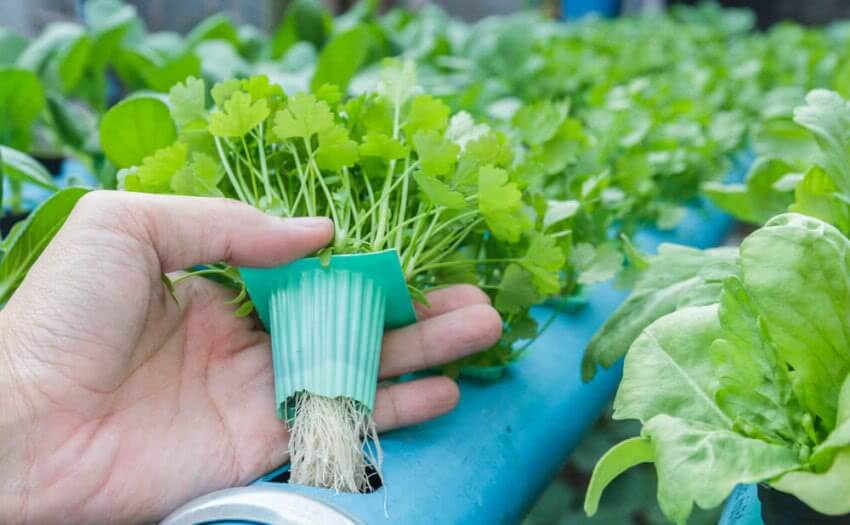Hydroponics is a super useful farming technique for gardening at home and growing your own food.
It is fashionable and considered by many to be an innovative practice, but it has been around for thousands of years. Ancient civilizations, such as the Mayans, used very similar agricultural techniques to develop their crops. We tell you what it is and how to do hydroponics to have a beautiful garden in your own home.
What is and how to do hydroponics
Table of Contents
Hydroponic cultivation is one in which water, and not soil, is used as the main material to grow a plant. In this type of technique, the nutrients and chemical elements necessary for the plant are dissolved in it, where they are absorbed by the roots. This means that water becomes the new source of sustenance, replacing the land in that function.
To do this, it is important to take into account the nutrients for hydroponics , that is, those elements that a plant needs to grow healthy and strong and that we must add to the water:
- Nitrogen
- Potassium
- Match
- Calcium
- Magnesium
- Sulfur
- Iron
- Manganese
- Zinc
- Boron
- Copper
- Silicon
- Molybdenum
Hydroponics at home: first steps
The advantage of home hydroponics is that it is very simple and does not involve the cleaning and maintenance work that large-scale hydroponic crops demand.
To start applying this technique in your garden, the first step is to get some elements:
- Nutritive solution for hydroponics : these are the nutrients that we named before, in different containers. You can make it at home or buy a ready-made hydroponic solution.
- Bucket or container : it should be 8 to 12 inches deep and should be black or dark in color so that light does not reach the roots.
- Wooden board : it must have the same dimension as the previous container.
- Air pump: ask about the same ones used in fish tanks. They are to oxygenate the water.
- Substrate to put as the base of the plants: it serves so that the crop can retain the nutrients it needs to live. It is the equivalent of organic compost for conventional crops.
- Plants (or seeds).
- A plastic or rubber stopper.
Do not panic. Not only is there a great variety and kits that allow you to have everything you need to make a hydroponic system at home, but it is quite simple to build if you have a little skill with crafts. You just need to manage to reuse certain materials and, in a few steps, make an ecological garden.
Hydroponic garden: set up at home
After getting the materials we mentioned above, it remains to get down to work to achieve your goal: a home hydroponic garden.
Here are the steps to follow:
- Punch a hole in the base of the container you chose. Remember that the depth has to be 20 or 30 centimeters. The plug (rubber or plastic) will go into the hole you make, to make a change of water from time to time.
- Make holes in the wooden board with a drill and make sure they are all the same size and with the same distance from each other. The number of holes you can make will depend on the size of your board.
- Thread the seedlings through the holes in the board very carefully to protect the roots. These must be submerged in the water in the container and the stem must remain on the surface.
- Before submerging the roots, surround them with substrate, which is what will give them support and protection.
- Oxygenate the water with the aerator pump two or three hours a day and check the levels of hydroponic solution constantly so that your plants receive what they need every day.
How to care for your hydroponic plants
To ensure that your hydroponic garden is in perfect condition, there are some recommendations that you should take into account:
- Change the water in the container every 15 days (removing the cap) and remember that you can use that same water to water other plants instead of throwing it away.
- To prevent pests, diseases or problems in your vegetables and plants, we recommend that you observe their development carefully. When you see any sign of something strange, such as white dots or some kind of fungus, check with the nursery where you usually buy.
- Make sure your plants get sunlight.
Advantages of hydroponics at home
The most notable benefit of home hydroponics is the ability to produce our own food without having to rely on others to produce it. In addition, we avoid the exploitation of more areas for agricultural use, making our garden a source of ecological food.
Another advantage of being encouraged to explore the benefits of hydroponics at home is that it is a system that guarantees a reliable source of food, free of pesticides or agrochemicals that can affect our health in the long term.
Being organic, we can ensure that hydroponic crops are healthier than those we buy in the supermarket, since we do not know the production process.
What we must bear in mind is that, although this type of crop does not involve land or depend on its conditions, it consumes a lot of water.
Disadvantages of hydroponics
Despite its many benefits, some disadvantages of hydroponics should be clarified so that you can approach your project with a realistic and orderly vision. First of all, I know that a hydroponic grow requires a lot of attention and precise supervision to get the plants to grow properly. This means two things: that hydroponics does not guarantee the success of a crop and that you have to invest more time in its care to achieve good results.
Another disadvantage is that the plants become very susceptible to any change because they are in optimal conditions to develop. This means that they lose their ability to adapt because they do not have to compete with any other or fight against any environmental condition. Hydroponic crops become “man-dependent”. At that point we could say that they are “fragile”.
Another disadvantage has to do with economics. The investment to have a hydroponic-based crop is not less, especially if you want to have a large garden. You have to buy materials and installations (pipes, pumps, stopcocks, etc.) and some elements are not cheap.
Likewise, it all depends on how you want to do it. Kits or proposals like the ones we tell you about before do not suppose as high a budget as others.
Another important issue, also linked to your time and your desire, is that to grow hydroponics you will have to “study”. If you have fun and can face it, great. But, depending on the person, this can be an advantage or a disadvantage. You just have to be clear that the plants grown with this method need very fine and specific care that requires you to inform yourself as much as possible.
If you don’t learn and do a little research about the hydroponic growing method, you are unlikely to be successful with your production. If you enjoy it and do it responsibly, it can be a beautiful adventure.

